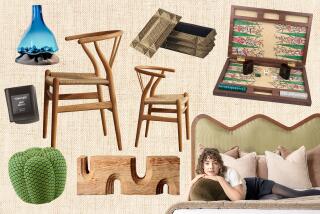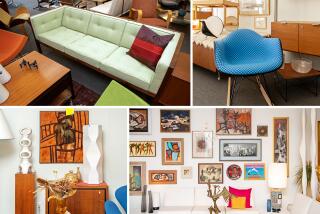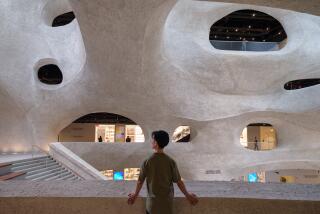Biedermeier Exhibit Shows Decorative Art : Display: Center offers a look at furnishings from post-Napoleonic period.
At the Decorative Arts Study Center in San Juan Capistrano, the focus is on the changing styles of furniture, residential architecture and home gardens.
“What (it’s) about is providing (people with) those tools to have the confidence and enthusiasm to stay home and create their own environment,” says G. R. (Gep) Durenberger, volunteer director of the center.
“Decorative art is defined as those items we use in our everyday existence, including everything we sit on, feed ourselves with and look at,” Durenberger says.
The center, across the street from the San Juan Capistrano Library, is housed in a unique complex of early California buildings and gardens. It opened in February, 1989.
Although the exhibits are fashioned by professional designers, they are not decorator showcases.
“We try not to be decorators,” Durenberger says. “We try not to be interpreters or edit what we’re doing here. This is as authentically correct as we can make it.”
The current exhibit showing in the main building, “Biedermeier: Neo-Classicism in German and Austrian Domestic Design: 1815-1848,” reflects the center’s dedication to detail and authenticity in its examination of domestic architecture and furnishings of the post-Napoleonic era.
The Biedermeier period is distinguished by its smaller-scale, unadorned furnishings made from local fruitwoods.
After Napoleon’s defeat, there was a conscious rejection of the ostentatious style of the French Empire. Massive, imposing furniture made from imported woods replete with gilding and complex designs were replaced with simple functional styles that emphasized comfort and function.
“This was a style of living that emanated from the middle classes themselves rather than filtering down from the courts,” Durenberger says.
Even the name accents the bourgeoisie nature of the style: bieder , meaning honest and straight-forward combines with meier, a common German surname.
One of the galleries exhibits the type of furniture that people revolted against, like the mercury gold on a bronze clock, and a gilded wood and silk fabric armchair.
In another gallery is a display of a typical apartment living room decorated in the Biedermeier style. Design innovations of the time included draping windows with elaborate fabrics and hanging fabrics on the wall. A pair of oil portraits, a solid cherry wood settee, an inlaid fruitwood worktable and a porcelain pitcher painted with pink and blue flowers celebrate the value of hard work and the importance of home and family.
Every Study Center exhibit includes a representative garden of the period on display.
The Biedermeier garden was typically geometric and very colorful, mixing a variety of colors in a small area. The intimate Study Center garden re-creates the feeling of the period when small gardens were treasured possessions of the middle class.
Adjacent to the garden is a tree-shaded courtyard with an old stone fountain. From here visitors can enter the gift shop to browse through an eclectic collection of art books, homemade jams, china and handcrafted items from local artisans. Thanks to the Elsie de Wolfe Foundation, the Study Center has a new library and classroom facility as well as Lady Mendl’s (De Wolfe’s married name) collection of paintings. De Wolfe is often referred to as the leader of 20th-Century interior design.
During December, an exhibition of antique and modern silver from the Tiffany Silver Collection will be on display along with several designer-decorated Christmas trees. Some of the trees will be auctioned to benefit the Study Center.
The Biedermeier exhibition will remain on display through Nov. 17. The Decorative Arts Study Center is at 31431 Camino Capistrano, San Juan Capistrano. (714) 496-2132. Open Tuesday through Saturday, 10 a.m. to 3 p.m. Suggested donation for non-members is $3. Docent-guided tours are available.


